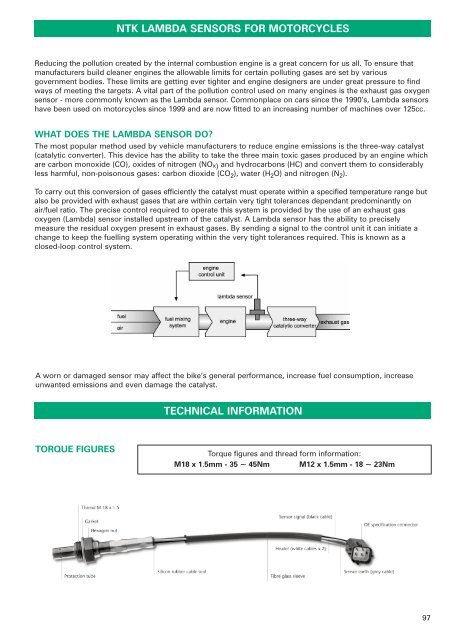Bikers won't fit anything else - Ekon
Bikers won't fit anything else - Ekon
Bikers won't fit anything else - Ekon
Create successful ePaper yourself
Turn your PDF publications into a flip-book with our unique Google optimized e-Paper software.
NTK LAMBDA SENSORS FOR MOTORCYCLES<br />
Reducing the pollution created by the internal combustion engine is a great concern for us all. To ensure that<br />
manufacturers build cleaner engines the allowable limits for certain polluting gases are set by various<br />
government bodies. These limits are getting ever tighter and engine designers are under great pressure to find<br />
ways of meeting the targets. A vital part of the pollution control used on many engines is the exhaust gas oxygen<br />
sensor - more commonly known as the Lambda sensor. Commonplace on cars since the 1990’s, Lambda sensors<br />
have been used on motorcycles since 1999 and are now <strong>fit</strong>ted to an increasing number of machines over 125cc.<br />
WHAT DOES THE LAMBDA SENSOR DO?<br />
The most popular method used by vehicle manufacturers to reduce engine emissions is the three-way catalyst<br />
(catalytic converter). This device has the ability to take the three main toxic gases produced by an engine which<br />
are carbon monoxide (CO), oxides of nitrogen (NOx) and hydrocarbons (HC) and convert them to considerably<br />
less harmful, non-poisonous gases: carbon dioxide (CO2), water (H2O) and nitrogen (N2). To carry out this conversion of gases efficiently the catalyst must operate within a specified temperature range but<br />
also be provided with exhaust gases that are within certain very tight tolerances dependant predominantly on<br />
air/fuel ratio. The precise control required to operate this system is provided by the use of an exhaust gas<br />
oxygen (Lambda) sensor installed upstream of the catalyst. A Lambda sensor has the ability to precisely<br />
measure the residual oxygen present in exhaust gases. By sending a signal to the control unit it can initiate a<br />
change to keep the fuelling system operating within the very tight tolerances required. This is known as a<br />
closed-loop control system.<br />
A worn or damaged sensor may affect the bike’s general performance, increase fuel consumption, increase<br />
unwanted emissions and even damage the catalyst.<br />
TORQUE FIGURES<br />
TECHNICAL INFORMATION<br />
Torque figures and thread form information:<br />
M18 x 1.5mm - 35 ~ 45Nm M12 x 1.5mm - 18 ~ 23Nm<br />
97


